Menu
-
MenuGeri
- Home
-
Kategoriler
-
-
Kategoriler
-
Sebze tohumları
-
Ülkelere Göre Çeşitler
- Ermenistan'dan çeşitler
- BH'den Çeşitler
- Hırvatistan'dan Çeşitler
- Fransa'dan Çeşitler
- Almanya'dan Çeşitler
- Yunanistan'dan Çeşitler
- Macaristan Çeşitleri
- Hindistan'dan Çeşitler
- İtalya'dan çeşitleri
- Japonya'dan Çeşitler
- Kuzey Makedonya çeşitleri
- Peru Çeşitleri
- Rusya'dan Çeşitler
- Sırbistan'dan Çeşitler
- Slovenya'dan Çeşitler
- İspanya Çeşitleri
- Tayland çeşitleri
- Türkiye'den Çeşitler
- ABD'den Çeşitler
- Domates tohumları
- Mısır tohumları
- Kabak ailesi
- Fasulye ailesi
- Salatalık tohumları
- Dolma biber tohumları
- Havuç ailesi
- Soğan ailesi
- Marul tohumları
- Patates ailesi
- Lahana ailesi
- Turp tohumları
- Pancar ailesi
- Karpuz tohumları
- Kavun tohumları
- Karnabahar tohumları
- Ayçiçeği ailesi
-
Ülkelere Göre Çeşitler
- Meyve tohumları
- Acı biber tohumları
- Tıbbi bitki tohumları
- Tırmanma bitki tohumları
- Ağaçlar - Çalı tohumları
- Palmiye tohumları
- Süs bitkileri tohumları
- Tütün tohumları
-
Sebze tohumları
-
-
-
-
- YENİ ÜRÜNLER
- Hesap oluştur
- Teslimat - Ödeme
- FAQ
Seeds Gallery markalı ürünlerin listesi
Seeds produced by Seeds Gallery
Seeds produced by Seeds Gallery
408 adet ürün var.
Sıralama ölçütü:
Toplam 408 üründen 361-375 arası gösteriliyor


Tiger Peanut Seeds (Arachis...
Fiyat
€2,25
(SKU: P 136 T)
Seeds Gallery EU,
5/
5
<h2><strong>Tiger Peanut Seeds (Arachis Hypogaea)</strong></h2>
<h2><span style="color:#ff0000;"><strong>Price for Package of 5 seeds.</strong></span></h2>
<p>110 days.One of the varieties grown during the 1800s was the African peanut (also known as the N. Carolina peanut). It may have been a black peanut, possibly the same as ‘Carolina Black.’ According to food historian William Woys Weaver, the black peanut may have been used as a substitute for Black Bambarra (African ground nut) by the black community. Black Bambarra is important in African folk medicine as an aphrodisiac. The N. Carolina climate won’t support black Bambarra, but black pea- nuts grow there without difficulty. Carolina Black produces sweet-tasting, black-skinned peanuts that are slightly larger than Spanish peanuts.</p>
<p>The peanut, or groundnut (Arachis hypogaea), is a species in the legume or "bean" family (Fabaceae). The peanut was probably first domesticated and cultivated in the valleys of Paraguay.[1] It is an annual herbaceous plant growing 30 to 50 cm (1.0 to 1.6 ft) tall. The leaves are opposite, pinnate with four leaflets (two opposite pairs; no terminal leaflet), each leaflet is 1 to 7 cm (⅜ to 2¾ in) long and 1 to 3 cm (⅜ to 1 inch) broad.</p>
<p>The flowers are a typical pea flower in shape, 2 to 4 cm (0.8 to 1.6 in) (¾ to 1½ in) across, yellow with reddish veining. Hypogaea means "under the earth"; after pollination, the flower stalk elongates causing it to bend until the ovary touches the ground. Continued stalk growth then pushes the ovary underground where the mature fruit develops into a legume pod, the peanut – a classical example of geocarpy. Pods are 3 to 7 cm (1.2 to 2.8 in) long, containing 1 to 4 seeds.[2]</p>
<p>Peanuts are known by many other local names such as earthnuts, ground nuts, goober peas, monkey nuts, pygmy nuts and pig nuts.[3] Despite its name and appearance, the peanut is not a nut, but rather a legume.</p>
<h3><strong>Cultivation</strong></h3>
<p>The orange-veined, yellow-petaled, pea-like flower of the Arachis hypogaea is borne in axillary clusters above ground. Following self-pollination, the flowers fade and wither. The stalk at the base of the ovary, called the pedicel, elongates rapidly, and turns downward to bury the fruits several inches in the ground, where they complete their development. The entire plant, including most of the roots, is removed from the soil during harvesting.[8] The fruits have wrinkled shells that are constricted between pairs of the one to four (usually two) seeds per pod.</p>
<p>Peanuts grow best in light, sandy loam soil. They require five months of warm weather, and an annual rainfall of 500 to 1,000 mm (20 to 39 in) or the equivalent in irrigation water.[9]</p>
<p>The pods ripen 120 to 150 days after the seeds are planted. If the crop is harvested too early, the pods will be unripe. If they are harvested late, the pods will snap off at the stalk, and will remain in the soil.[8] They need an acidic soil to grow preferably with 5.9-7 pH.</p>
<p>Peanuts are particularly susceptible to contamination during growth and storage. Poor storage of peanuts can lead to an infection by the mold fungus Aspergillus flavus, releasing the toxic and highly carcinogenic substance aflatoxin. The aflatoxin-producing molds exist throughout the peanut growing areas and may produce aflatoxin in peanuts when conditions are favorable to fungal growth.</p>
<p>Harvesting occurs in two stages[citation needed]: In mechanized systems, a machine is used to cut off the main root of the peanut plant by cutting through the soil just below the level of the peanut pods. The machine lifts the "bush" from the ground and shakes it, then inverts the bush, leaving the plant upside down on the ground to keep the peanuts out of the soil. This allows the peanuts to dry slowly to a bit less than a third of their original moisture level over a period of three to four days. Traditionally, peanuts were pulled and inverted by hand.</p>
<p>After the peanuts have dried sufficiently, they are threshed, removing the peanut pods from the rest of the bush.</p>
<h3><strong>Uses</strong></h3>
<p>Peanuts have many uses. They can be eaten raw, used in recipes, made into solvents and oils, medicines, textile materials, and peanut butter, as well as many other uses. Popular confections made from peanuts include salted peanuts, peanut butter (sandwiches, peanut candy bars, peanut butter cookies, and cups), peanut brittle, and shelled nuts (plain/roasted). Salted peanuts are usually roasted in oil and packed in retail-size plastic bags or hermetically sealed cans. Dry roasted salted peanuts are also marketed in significant quantities. Peanuts are often a major ingredient in mixed nuts because of their relative cost compared to Brazil nuts, cashews, walnuts, and so on. Although peanut butter has been a tradition on camping trips and the like because of its high protein content and because it resists spoiling for long periods of time, the primary use of peanut butter is in the home. Large quantities are also used in the commercial manufacture of sandwiches, candy, and bakery products. Boiled peanuts are a preparation of raw, unshelled green peanuts boiled in brine and often eaten as a snack. More recently, fried peanut recipes have emerged – allowing both shell and nut to be eaten. Peanuts are also used in a wide variety of other areas, such as cosmetics, nitroglycerin, plastics, dyes and paints.</p>
<h3><strong>Peanut oil</strong></h3>
<p>Peanut oil is often used in cooking because it has a mild flavor and a relatively high smoke point. Due to its high monounsaturated content, it is considered more healthy than saturated oils and is resistant to rancidity. There are several types of peanut oil including aromatic roasted peanut oil, refined peanut oil, extra virgin or cold-pressed peanut oil and peanut extract. In the United States, refined peanut oil is exempt from allergen labeling laws.</p>
<h3><strong>Peanut flour</strong></h3>
<p>Peanut flour is lower in fat than peanut butter and is popular with chefs because its high protein content makes it suitable as a flavor enhancer[citation needed]. Peanut flour is used as a gluten-free solution.</p>
<h3><strong>Boiled peanuts</strong></h3>
<p>Boiled peanuts are a popular snack in the southern United States, as well as in India, China and West Africa.</p>
<h3><strong>Dry roasted peanuts</strong></h3>
<p>Dry peanuts can be roasted in the shell in a home oven if spread out one layer deep in a pan and baked at a temperature of 350°F or 177°C for 18–20 minutes.</p>
<h3><strong>Cuisine</strong></h3>
<h3><strong>South America</strong></h3>
<p>Peanuts are used in many sauces for South American meat dishes, especially rabbit. Peanuts are common in Peruvian cuisine, which marries native and European ingredients. For instance, roasted peanuts and hot peppers, both native to South America, appear with roasted onions, garlic, and oil—all of European origin—in a smooth sauce poured over boiled potatoes, a dish well known in the city Arequipa and called papas con ocopa. Another example is a fricassee combining a similar mixture with sautéed seafood or boiled and shredded chicken. These dishes are generally known as ajíes, meaning "hot peppers", such as ají de pollo and ají de mariscos. (Seafood ajíes may omit peanuts.)</p>
<p>Likewise, during Colonial times, the Spanish in Peru used peanuts to replace nuts unavailable in Peru but used extensively in Spanish cuisine, such as almonds, pine nuts, and other nuts, typically ground or as paste and mixed with rice, meats, and vegetables for dishes such as rice pilaf.</p>
<h3><strong>Southwest Asia</strong></h3>
<p>Crunchy coated peanuts, called kabukim in Hebrew, are a popular snack in Israel. Kabukim are commonly sold by weight at corner stores where fresh nuts and seeds are sold, though they are also available packaged. The coating typically consists of flour, salt, starch, lecithin, and sometimes sesame seeds. The origin of the name is obscure.(It may be derived from kabuk which means nutshell or husk in Turkish.) An additional variety of crunchy coated peanuts popular in Israel is "American peanuts". The coating of this variety is thinner, but harder to crack.</p>
<p>Another popular Israeli peanut snack, Bamba puffs, is similar in shape to Cheez Doodles, but are made of corn and flavored with peanut butter.</p>
<h3><strong>Southeast Asia</strong></h3>
<p>Peanuts are also widely used in Southeast Asian cuisine, particularly Indonesia, where they are typically made into a spicy sauce. Peanuts originally came to Indonesia from the Philippines, where the legume came from Mexico in times of Spanish colonization.</p>
<p>Common Indonesian peanut-based dishes include gado-gado, pecel, karedok and ketoprak, all vegetable salads mixed with peanut sauce, and the peanut-based sauce for satay.</p>
<p>In the Indian subcontinent, peanuts are known as a light snack by themselves, usually roasted and salted (sometimes with the addition of chilli powder), and often sold roasted in pod, or boiled with salt. They are also made into little dessert or sweet snack pieces by processing with refined sugar and jaggery. Indian cuisine uses roasted, crushed peanuts to give a crunchy body to salads; they are added whole (without pods) to leafy vegetable stews for the same reason. Another use of peanut oil as cooking oil. Most Indians use mustard, sunflower, and peanut oil for cooking. Peanuts are not native to India. They are thought to have come to India from Philippines. Notably, the name of this nut in northern parts of Tamil Nadu is 'மணிலாக் கொட்டை'- slang மல்லாக் கொட்டை- (Manila-k-kottai) means nut from Manila, the capital city of Philippines.</p>
<h3><strong>West Africa</strong></h3>
<p>Peanuts grow well in southern Mali and adjacent regions of the Ivory Coast, Burkina Faso, Ghana, Nigeria and Senegal; peanuts are similar in both agricultural and culinary qualities to the Bambara groundnut native to the region, and West Africans have adopted the crop as a staple. Peanut sauce, prepared with onions, garlic, peanut butter/paste, and vegetables such as carrots, cabbage, and cauliflower, can be vegetarian (the peanuts supplying ample protein) or prepared with meat, usually chicken.</p>
<p>Peanuts are used in the Mali meat stew maafe. In Ghana, peanut butter is used for peanut butter soup nkate nkwan.[13] Crushed peanuts may also be used for peanut candies nkate cake and kuli-kuli, as well as other local foods such as oto.[13] Peanut butter is also an ingredient in Nigeria's "African salad".</p>
<p>Peanut powder is an important ingredient in the spicy coating for kebabs in Nigeria and Ghana.</p>
<h3><strong>East Africa</strong></h3>
<p>Peanuts are a common ingredient of several types of relishes (dishes which accompany nshima) eaten by the tribes in Malawi and in the eastern part of Zambia, and these dishes are now common throughout both countries. Thick peanut butter sauces are also made in Uganda to go with rice and other starchy foods. Across East Africa, roasted peanuts (often in cones of newspaper) are a popular snack sold in the street.</p>
<h3><strong>North America</strong></h3>
<p>In the US, peanuts are used in candies, cakes, cookies, and other sweets. They are also enjoyed roasted and salted. Peanut butter is one of the most popular peanut-based foods in the US, and for four hundred years, recipes for peanut soup have been present in the South, Virginia in particular. In some southern portions of the US, peanuts are boiled for several hours until soft and moist. Peanuts are also deep-fried, shell and all.</p>
<h3><strong>Malnutrition</strong></h3>
<p>Peanuts are used to help fight malnutrition. Plumpy Nut, MANA Nutrition,[14] and Medika Mamba[15] are high-protein, high-energy and high-nutrient peanut-based pastes developed to be used as a therapeutic food to aid in famine relief. The World Health Organization, UNICEF, Project Peanut Butter and Doctors Without Borders have used these products to help save malnourished children in developing countries.</p>
<h3><strong>Other uses</strong></h3>
<p>Peanuts can be used like other legumes and grains to make a lactose-free milk-like beverage, peanut milk. Peanut plant tops are used for hay.</p>
<p>Low-grade or culled peanuts not suitable for the edible market are used in the production of peanut oil for manufacturing.[citation needed] The protein cake (oilcake meal) residue from oil processing is used as an animal feed and as a soil fertilizer. Low-grade peanuts are also widely sold as a garden birds feed.</p>
<p>Peanuts have a variety of industrial end uses. Paint, varnish, lubricating oil, leather dressings, furniture polish, insecticides, and nitroglycerin are made from peanut oil. Soap is made from saponified oil, and many cosmetics contain peanut oil and its derivatives. The protein portion is used in the manufacture of some textile fibers. Peanut shells are used in the manufacture of plastic, wallboard, abrasives, fuel, cellulose (used in rayon and paper) and mucilage (glue). Rudolf Diesel ran some of the first engines that bear his name on peanut oil[16] and it is still seen as a potentially useful fuel.</p>
<p>Plant Common Name: Peanut seeds</p>
<p>Plant Genus/Species Name: Arachis hypogaea</p>
<p>Sowing Temperature: 16 - 26 Celcius</p>
<p>Growing Temperature: 8 - 38 Celcius</p>
<p>Days to Maturity: 60-80 Days</p>
<h2><span style="color:#008000;"><strong>How to Sow Peanut</strong></span></h2>
<p>Peanuts need a long, hot growing season to fully mature. Do not plant in areas that do not have at least 4-5 months of frost-free weather. Shell the seeds before sowing. In loose, well-drained soil in a sunny location, sow seeds directly outdoors after the last frost. Plant in light deeply dug and prepared alkaline soil. Create a furrow 2" deep and sow seeds 4-6" apart, being careful not to damage the tender seeds. Space rows 3' apart. Seeds germinate in 10-15 days.</p>
P 136 T (5 S)


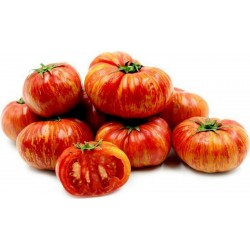
Tigerella Tomato seeds
Fiyat
€1,85
(SKU: VT 19)
Seeds Gallery EU,
5/
5
<h2><strong>Tigerella Tomato seeds</strong></h2>
<h2><span style="color: #ff0000;"><strong>Price for Package of 10 seeds.</strong></span></h2>
<p>Tigerella is a bi-colored tomato cultivar, relatively small, 2 to 4 ounces (60-120 g), and early (59 days). Upon maturity, the fruit is red with yellow stripes, essentially the same as Green Zebra, except that the fruit is red instead of green, and has a sweeter flavor.</p>
<p>Tigerella heirloom tomatoes were developed in the 1950s by Dr. Lewis Darby of Great Britain, maybe. Other sources state that Tigerella tomato seeds were bred by the Glasshouse Research Institute in England in the 1930s as a cross between an unknown cultivar and Ailsa Craig.</p>
<p>A stunning Heirloom standard-sized round variety with red-orange skin and golden-green to yellow jagged stripes. It crops reliably and heavily up to 3 Weeks earlier than Moneymaker and grows well outdoors or in a greenhouse in all areas with a rich, tangy flavor. Cordon (Indeterminate).</p>
<p><span style="font-family: verdana, geneva, sans-serif;"><strong>What's the difference between "indeterminate" and "determinate" tomatoes?</strong></span></p>
<p><span style="font-family: verdana, geneva, sans-serif;"><strong>Determinate tomatoes</strong>, or "bush" tomatoes, are varieties that grow to a compact height (generally 3 - 4'). Determinates stop growing when fruit sets on the top bud. All the tomatoes from the plant ripen at approximately the same time (usually over a period of 1- 2 weeks). They require a limited amount of staking for support and are perfectly suited for container planting.</span></p>
<p><span style="font-family: verdana, geneva, sans-serif;"><strong>Indeterminate tomatoes</strong> will grow and produce fruit until killed by frost. They can reach heights of up to 12 feet although 6 feet is normal. Indeterminates will bloom, set new fruit and ripen fruit all at the same time throughout the season. They require substantial staking for support and benefit from being constrained to a central growing stem.</span></p><script src="//cdn.public.n1ed.com/G3OMDFLT/widgets.js"></script>
VT 19 (10 S)


Ermenistan'dan Çeşit
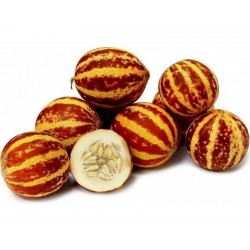
Tigger Kavun Tohumları
Fiyat
€4,95
(SKU: V 46)
Seeds Gallery EU,
5/
5
<meta http-equiv="Content-Type" content="text/html; charset=UTF-8" />
<h2><strong>Tigger Kavun Tohumları</strong></h2>
<h2><span style="color: #ff0000;"><strong>5 tohum paketi için fiyat.</strong></span></h2>
<p>Güçlü ve yoğun bir egzotik tat ve koku ile karakterizedir ve aynı zamanda çok dekoratiftir. Küçük boyutlu meyveler 150-450 gr ağırlığındadır. Tigger kavun bitkileri asma başına yirmi kavun verebilir. Yetiştirdiğimiz en muhteşem görünümlü kavun.</p>
<p>Tigger kavunun yumuşak kabuğu, dikey pas turuncu ve sarı renklere sahiptir. Kavunun kremsi, kirli beyaz eti sulu ve tatlıdır ve Asya armudu ve kavun ile karşılaştırılan bir tada sahiptir. Çoğu misk kavunu türü gibi, oldukça aromatik bir koku sunar ve olgunluğun zirvesindeyken içinde bulundukları tüm odayı parlattığı bilinmektedir. Tigger kavunları, yaklaşık olarak bir softball büyüklüğünde büyüyecek ve tamamen olgunlaştıklarında mütevazı bir pound ağırlığında olacaktır.</p>
<p>Tigger kavunu ilk olarak Dicle Nehri yakınında eski batı Ermenistan'da keşfedildi. Çoğu kavun çeşidi gibi, ılıman ve Akdeniz bölgelerinde yazın ılıktan sıcağa büyüyen günlerini tercih eder. Tırmanan asmalar üzerinde büyüyen Tigger kavunun küçük boyutu, onu nispeten küçük alanlarda yetiştirilmesine izin veren kafes için ideal hale getirir.</p>
V 46 (5 S)

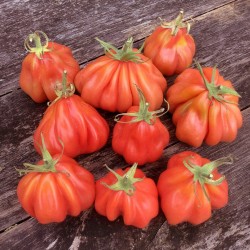
Tlacolula Ribbed Heirloom...
Fiyat
€1,95
(SKU: VT 40)
Seeds Gallery EU,
5/
5
<h2><strong>Tlacolula Ribbed Heirloom tomato Seeds</strong></h2>
<h2><span style="color:#ff0000;"><strong>Price for Package of 10 seeds.</strong></span></h2>
<p>Tlacolula de Matamoros is likely where the name of this tomato came from and is a city situated in the state of Oaxaca. Tlacolula, as one might expect, is a Nauhatl word. The exact translation doesn’t seem to be too clear, but it is usually attributed to meaning “place of many sticks” or “twisted thing”. The latter could very well apply to this tomato.</p>
<p>While this tomato isn’t literally twisted, it is of a characteristic heavily ribbed/pleated shape that quite a few tomatoes possess that come from in and around this region of Mexico. When I see a heavily pleated tomato, I must have it. I’m a sucker for the pleats. And when I learn a tomato is traced back to these areas of Central America? That’s the clincher.</p>
<p><strong>The Look</strong></p>
<p>As previously mentioned, this is one of those lovely awe-inspiring heavily pleated/ruffled tomatoes. My mom characterizes these as “looking like peppers”. This one reminded me quite a bit of ‘Zapotec Pink Pleated’, except it was more red then pink. The fruit was smaller than the Zapotec tomato as well, getting about 3-4″ in diameter and weighing in at about 8-10oz each (as opposed to Zapotec’s 4-6″ in diameter and 1-1.5lb weights). They are another hollow tomato, but once again, not quite as hollow I found as Zapotec Pink Pleated.</p>
<p><strong>The Taste</strong></p>
<p>This is a good fresh eating tomato. Despite its red flavour, it’s low in acidity, so it’s good for people with stomach problems who don’t want to limit themselves to whites, yellows, and orange tomatoes. It’s great for stuffing and then baking, although because of it’s mild flavour after it’s baked you don’t get a ton of tomatoeyness to go with whatever you’re cooking.</p>
<p>Slightly hollow, firm flesh with moderate juice. Good taste!</p>
VT 40 (10 S)


Soğuğa ve dona dayanıklı bitki
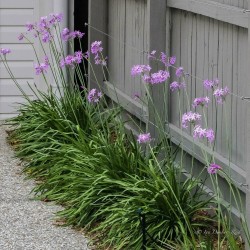
Tohumlar Derneği Sarımsak...
Fiyat
€1,95
(SKU: MHS 85)
Seeds Gallery EU,
5/
5
<meta http-equiv="Content-Type" content="text/html; charset=UTF-8" />
<h2><strong>Tohumlar Derneği Sarımsak (Tulbaghia violacea)</strong></h2>
<h2><strong><span style="color: #ff0000;">10 tohum paketi için fiyat.</span></strong></h2>
<p>Toplum sarımsak olarak da bilinen Tulbaghia violacea, Güney Afrika'ya (KwaZulu-Natal ve Cape Province) yerli olan ve Tanzanya ve Meksika'da doğallaştırıldığı bildirilen Amaryllidaceae familyasındaki çiçekli bitki türüdür. Boyu 25 cm (10 inç) genişliğinde 60 cm'ye (24 inç) kadar büyüyen, dar yaprakları ve orta yazdan sonbahara (sonbahar) büyük kokulu, mor çiçekler kümeleriyle yığın oluşturan çok yıllık bir bitkidir.</p>
<p>yetiştirme<br />Bir süs olarak yetiştirildiğinde, bu bitki kış donlarından biraz koruma gerektirir. Bu tür ve krema kenarlı yaprakları olan "Mor Göz" ve "Gümüş Dantel" çeşitlerinin hepsi [6] Kraliyet Bahçe Bitkileri Derneği'nin Bahçe Liyakati Ödülünü kazanmıştır.</p>
<p>Tıbbi kullanımlar<br />Tulbaghia violacea, yerel olarak çeşitli rahatsızlıkları tedavi etmek için bitkisel bir ilaç / ilaç olarak kullanılır. Son zamanlarda in vitro androjenik ve anti-kanser özelliklerine sahip olduğu gösterilmiştir.</p>
<p>Tulbaghia violacea, sarımsakta bulunanlardan daha yüksek antitrombotik aktiviteler sergiledi.</p>
<p>Koku<br />Her iki kokuya aşina olanlara esrar veya kokarca gibi kokabilir. İlgili komşuların yetkililerle mahalledeki esrar kokusu hakkında yalnızca suçlu aslında limon mine çiçeği veya toplum sarımsak olduğunu öğrenmek için temasa geçtikleri durumlar olmuştur.</p>
MHS 85 (10 S)


Sırbistan'dan Çeşit

Soğuğa ve dona dayanıklı bitki
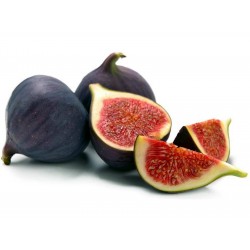
Tohumlar İncir (Ficus carica)
Fiyat
€1,95
(SKU: V 19 CF)
Seeds Gallery EU,
5/
5
<!DOCTYPE html>
<html>
<head>
<meta http-equiv="Content-Type" content="text/html; charset=UTF-8" />
</head>
<body>
<h2><strong>Tohumlar İncir (Ficus carica)</strong></h2>
<h2><span style="color: #ff0000;"><strong>100 (0.05g) tohum paketi için fiyat.</strong></span></h2>
<p><b>İncir</b><span> </span>(<i>Ficus carica</i>), anavatanı doğu<span> </span>Akdeniz<span> </span>ve güneybatı<span> </span>Asya<span> </span>(Türkiye'den<span> </span>Afganistan'a kadar) olan,<span> </span>ağaç<span> </span>ya da<span> </span>ağaççık<span> </span>nitelikli bir<span> </span>bitki<span> </span>türü<span> </span>ve bu türün<span> </span>meyvesidir.</p>
<p>İncir,<span> </span>dutgiller<span> </span>(Moraceae)<span> </span>familyasına<span> </span>dahil olan<span> </span><b>incir</b><span> </span><i>(Ficus)</i><span> </span>cinsinin<span> </span>içerdiği yaklaşık 800 kadar tür içinde ticari öneme sahip<span> </span>meyve<span> </span>veren tek bitkidir. Dişi ve erkek olarak ağaçları ikiye ayrılır, aynı ağaç üstünde hem dişi hem de erkek nitelikli organlar bulunmaz. Dişi ağaçların meyvesi büyük ve fazladır, erkek ağaçların ise ufak ve az meyvesi bulunmakla meyvesi dişilerininki gibi yenilebilir lezzette de değildir ancak tozlaşma için gereklidir. Genelde tozlaşma için pek çok dişi ağacın yakınına sadece bir tane erkek ağaç dikilir. İncir bitkisinin çiçeklerinde<span> </span>tozlaşma<span> </span>olayı mazı böcekleriyle gerçekleşir. Bu olaya "<i>Kaprifikasyon</i>" denir.</p>
<p>Meyvelerinin<span> </span>besin değeri yüksektir. Meyvelerin bileşimini %30-40<span> </span>şeker, A,B,C vitaminleri oluşturmaktadır.</p>
<p>2005 yılı<span> </span>FAO<span> </span>verilerine göre Dünya'da 1.057.000-Ton incir üreilmiş olup, incirin Dünya'daki en büyük üreticisi 280.000 ton ile<span> </span>Türkiye'dir. Bunu 170.000-Ton ile<span> </span>Mısır<span> </span>ve diğer Akdeniz ülkeleri takip etmektedir. Başlıca dış satım ürünümüzdür. Ege bölgesinde tarımda ön planda yer alır. Türkiye'de en fazla<span> </span>Aydın<span> </span>yöresinde yetiştirilir.</p>
</body>
</html>
V 19 CF (0,05g)

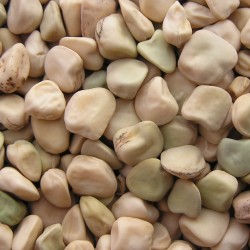
Tohumu çim bezelye, mavi...
Fiyat
€1,55
(SKU: VE 46 (5,5g))
Seeds Gallery EU,
5/
5
<h2 class=""><strong>Tohumu çim bezelye, mavi tatlı bezelye (Lathyrus sativus)</strong></h2>
<h2><span style="color: #ff0000;" class=""><strong>20 (5,5g) tohum paketi için fiyat.</strong></span></h2>
<p><i><b>Lathyrus sativus</b></i><span> olarak da bilinen,</span><b><span> </span>çim bezelye</b><span> ,</span><b><span> </span>mavi tatlı bezelye</b><span> ,</span><b><span> </span>chickling bezelye</b><span> ,</span><b><span> </span>chickling fiğ</b><span> ,</span><b><span> </span>Hint bezelye</b><span> ,</span><b><span> </span>beyaz bezelye</b><span> ve</span><b><span> </span>beyaz fiğ</b><span> , bir olan</span><span> </span>baklagil<span> (aile</span><span> </span>Fabaceae<span> yaygın insan tüketimi ve için yetiştirilen)</span><span> </span>hayvancılık<span> konusu yayının</span><span> </span>Asya<span> ve</span><span> </span>Doğu Afrika'da<span> . Bu yatkındır alanlarda özellikle önemli mahsul olan</span><span> </span>kuraklık<span> ve</span><span> </span>kıtlık<span> ve diğer tüm ekinler başarısız olduğunda güvenilir ürün verdiği gibi bir sigorta mahsulün 'olarak düşünülür. Tohumlar</span><span> </span>, bir nörodejeneratif hastalığın neden olan bir nörotoksini içeren<span> tohumlar uzun bir süre için bir birinci protein kaynağı olarak tüketilir.</span></p>
<h2><span class="mw-headline" id="Cultivation">yetiştirme</span></h2>
<p><i>Lathyrus sativus</i><span> </span>ortalama sıcaklığı 10-25 ° C, ortalama yağış yılda 400-650 mm (16-26 inç) burada en büyür. Diğer baklagiller gibi, toprağın nitrojen içeriğini artırır. Ekin yaşayabilir<span> </span>kuraklık<span> </span>veya<span> </span>sel<span> </span>, ama nemli topraklarda iyi yetişir. Işık ağır kil tınlı yoluyla kumlu, ve asit, nötr ya da alkalin topraklar toprak tiplerine tolere eder. Bu gölge tahammül etmez.</p>
<p>Tohum içinde pazarlarda insan tüketimi için satılan<span> </span>Florence<span> </span>. Bu tüketimi<span> </span>darbesi<span> </span>İtalya'da ülkenin orta kesiminde bazı alanlarda sınırlıdır ve giderek azalmaktadır.</p>
<p>Çim bezelye (yapılmış Un<span> </span>İspanyolca<span> </span>:<span> </span><i>almorta</i><span> </span>) için ana madde<span> </span><i>gachas<span> </span>manchegas</i><span> </span>veya<span> </span><i>gachas de almorta</i><span> </span>. Çanak için Accompaniments boyunca değişiklik<span> </span>La Mancha<span> </span>. Bu eski bir<span> </span>Manchego mutfağı<span> </span>genelde soğuk kış aylarında tüketilen zımba. Çanak genellikle bir kaşık ya da ekmek basit dilim kullanılarak, pişmiş edildiği tava doğrudan dışarı yenir. Bu yemek genellikle kişinin dudakları veya dilini yakmamaya dikkat ederek, ateşten çıkarmadan hemen sonra tüketilmektedir.</p>
<p>Toksisitesi nedeniyle, insan tüketimi için 1967 yılından bu yana İspanya'da yasaktır. Hayvan yemi olarak satılabilir ama insan tüketimi için diğer unların geçerli yakınında görüntülenemiyor (BOE-2484/1967. 21 Eylül. Paragraflar 3.18.09 a ve b ve 5.36.16 b)</p>
<p>Çim bezelye unu özellikle saf bir şekilde, Castilla-La Mancha dışında elde etmek son derece zordur. Ticari olarak temin edilebilen<span> </span><i>almorta</i><span> </span>çim bezelye zaman uzun süreler için önemli ölçüde büyük miktarlarda tüketilen halinde zehirli oldukları için unu buğday unu ile karıştırılır.</p>
<p>Kasaba<span> </span>Alvaiázere<span> </span>Portekiz nabız içeren yemekler için birkaç gün süren bir festival ayırır. Alvaiázere kendisini başkenti çağırır<span> </span><i>Chícharo</i><span> </span>, Portekizce bu darbenin adının.</p>
<p>Olgunlaşmamış tohumlar yeşil bezelye gibi yenebilir.<span> </span><i>L. sativus</i><span> </span>toksinleri azaltmak için ıslatma ve kapsamlı pişirme ihtiyacı var.</p>
<p>Yaprakları ve sapı pişmiş gibi yenir<span> </span><i>chana destan</i><span> </span>(<span> </span>Odia<span> </span>: bölgelerinde ଚଣା ଶାଗ)<span> </span>Odisha<span> </span>, Hindistan.</p>
<h3><span class="mw-headline" id="Seed_ODAP_characteristics">Tohum ODAP karakteristikleri</span></h3>
<p>Diğer tahıl baklagiller gibi,<span> </span><i>L. sativus</i><span> </span>bir yüksek üreten<span> </span>bir protein<span> </span>tohum. Tohumlar aynı zamanda, değişken miktarlarda içeren<span> </span>nörotoksik<span> </span>bir amino asit<span> </span>β-N-oksalil-L-α, β-diaminopropionik asit<span> </span>(ODAP). ODAP hastalığın nedeni olarak kabul edilir<span> </span>nörolatirizm<span> </span>, bir<span> </span>nörodejeneratif<span> </span>neden hastalık<span> </span>felç<span> </span>alt gövdenin: bir lokal anestezinin (kalçalar) zayıflaması. Hastalık sonra oluşmaya görülmüştür<span> </span>kıtlık<span> </span>Avrupa'da (Fransa, İspanya, Almanya), Kuzey Afrika ve içinde<span> </span>Güney Asya<span> </span>ve hala yaygın olduğu<span> </span>Eritre<span> </span>,<span> </span>Etiyopya<span> </span>, ve<span> </span>Afganistan<span> </span>(dilenen) ne zaman<span> </span><i>Lathyrus</i><span> </span>tohum münhasır veya ana kaynağıdır uzun süre besin. Bitkilerde ODAP konsantrasyonu artar sorunu bileşik, stresli koşullar altında yetiştirilir.</p>
<blockquote class="templatequote">
<p>Ekin küçük miktarlarda insanlara zararsızdır, ancak üç aylık bir süre içinde diyetinin önemli bir parçası olarak yeme çocuklarda kalıcı yetişkinlerde dizlerinin altına felç ve beyin hasarı, latirizm olarak bilinen bir hastalığa neden olabilir. (<span> </span>Kew Gardens<span> </span>)</p>
</blockquote>
<p>Bazı yazarlar bu toksisite abartılmış olduğunu iddia ettiler ve<span> </span><i>L. sativus</i><span> </span>normal diyetin bir parçası olarak zararsızdır. Bu baklagil, L-homoarginin bilinen tek beslenme kaynağı ve daha fazla tercih edilir<span> </span>arginin<span> </span>için<span> </span>nitrik oksit<span> </span>(NO) üretimi. L-ODAP kalsiyuma bağımlı bir aktivatörü olarak etki gösterdiği,<span> </span>protein kinaz C<span> </span>.</p>
<p>Islah programları satırlarını üretmek için çalışmalar devam etmektedir<span> </span><i>L. sativus</i><span> </span>az ODAP üretirler.</p>
<blockquote class="templatequote">
<p>Batı Asya'dan bazı çeşitleri nörotoksin ve yetiştiricilerin ve çiftçilerin düşük seviyede artık aynı zamanda toksik bileşiğin güvenli seviyesini elde ederken, zorlu koşullarda toleransı korumak çeşitleri geliştirmek için bu genetik çeşitliliğin keşfediyoruz var.</p>
</blockquote>
<p>Mahsul yabani akrabaları kültivarları iyileştirmek için aday olabilir genetik materyalin, belirgin kaynağıdır.<span> </span>ICARDA<span> </span>halen değerlendirmekte olan<span> </span>mahsul yabani akrabaları<span> </span>biyotik / abiyotik streslere düşük veya hiç ODAP ve dayanıklı / toleranslı olan genleri keşfetmek ve ekili çim bezelye aktarmak için.</p>
<script src="//cdn.public.n1ed.com/G3OMDFLT/widgets.js"></script>
VE 46 (5,5g)


Sırbistan'dan Çeşit
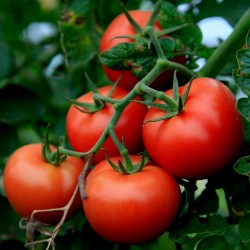
Tomato Novosadski Jabucar...
Fiyat
€2,15
(SKU: VT 130)
Seeds Gallery EU,
5/
5
<h2 class=""><strong>Tomato Novosadski Jabucar 50 seeds</strong></h2>
<h2><span style="color: #ff0000;"><strong>Price for Package of 50 seeds.</strong><strong><br></strong></span></h2>
<div>70-80 days, Medium early variety, Indeterminate. The fruits are round, smooth, bright red, average weight is 130-150 g. He has a good ratio of total sugar and acid, with a dry matter content of 6 to 6.5% and a very good taste. It can be grown from seeds, and without support.</div>
<div>History:</div>
<div>Old tested variety from Serbia. 'Jabucar' means 'Apple' in Serbian.</div><script src="//cdn.public.n1ed.com/G3OMDFLT/widgets.js"></script>
VT 130 (50 S)


Almanya'dan çeşitli
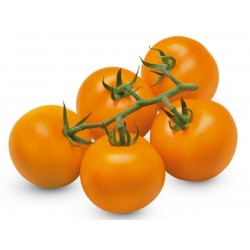
Tomato Seed AURIGA (Solanum...
Fiyat
€1,85
(SKU: VT 150)
Seeds Gallery EU,
5/
5
<h2><strong><em><span style="text-decoration: underline;" class="">Tomato Seed AURIGA (Solanum lycopersicum)</span></em></strong></h2>
<h3><span style="color: #ff0000;"><strong>Price for Package of 10 seeds. </strong></span></h3>
<p>This is a lovely variety of tomato from east Germany, and is particularly well suited for outdoor growing - in fact, it is just as happy growing outside as it is under protection.</p>
<p>Fairly early to start ripening, the fruits are just a little smaller than a billiard ball in size. Thin-skinned, they are extremely sweet and juicy. If you let them mature on a little longer to 'very ripe' the flavor of the fruit changes to a gorgeous almost Melon taste - very distinctive!</p>
<p>Vigorous but compact inhabit this is a such a good variety in so many ways!</p>
<p>This is an indeterminate variety and best grown as a cordon (vine)</p>
<p>For best yields and size of fruit - stop at 5th truss if growing under protection (4th outside)</p>
<p>Suitable for growing both outsides and under protection.</p><script src="//cdn.public.n1ed.com/G3OMDFLT/widgets.js"></script>
VT 150 (10 S)


Rusya'dan çeşitli
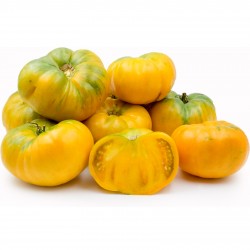
Tomato Seeds Persimmon Orange
Fiyat
€1,85
(SKU: VT 161)
Seeds Gallery EU,
5/
5
<!DOCTYPE html>
<html>
<head>
<meta http-equiv="Content-Type" content="text/html; charset=UTF-8" />
</head>
<body>
<h2><span style="text-decoration: underline;"><em><strong>Tomato Seeds Persimmon Orange</strong></em></span></h2>
<h3><span style="color: #ff0000;"><strong>Price for Package of 10 seeds.</strong></span></h3>
<div>This plant produces good yields golden-orange tomatoes weighing from 1-2 lbs. This fruit has a mild sweet flavor, meaty in texture, and have relatively few seeds. This variety originated in Russia. Determinate. Plant reaches 3 ft in height. 80 days.</div>
</body>
</html>
VT 161


Amerika Birleşik Devletleri'nden çeşitli
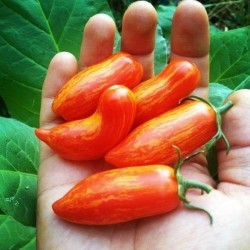
Tomato Seeds SWEET CASADAY
Fiyat
€1,95
(SKU: VT 63)
Seeds Gallery EU,
5/
5
<!DOCTYPE html>
<html>
<head>
<meta http-equiv="Content-Type" content="text/html; charset=UTF-8" />
</head>
<body>
<h2><strong>Tomato Seeds SWEET CASADAY</strong></h2>
<h2><span style="color: #ff0000;"><strong>Price for Package of 5 seeds.</strong></span></h2>
<p>Sweet Casady is a small (5cm long and about 25g in weight) elongated plum tomato that is bright red with yellow/orange stripes. It very sweet and also beautiful (a rare combination) – A lovely plum/cherry tomato with a unique shape and look and incredibly productive and tasty! </p>
<p>Sweet Casaday is a great fresh eating tomato for home and market gardeners in the style of the Artisan-tomatoes. It has beautiful elongated red plum tomatoes with yellow stripes.<br />The attractive fruits are about 5 cm long, sweet with excellent full tomato flavour. They are ideal for fresh eating. ‘Sweet Casaday’ is very suitable for canning as well and makes also an excellent tomato paste. It is an indeterminate variety. Its beautiful appearance makes it a perfect variety for home gardeners. It is very versatile and can be grown successfully on patios and big balconies because it does well in large containers.<br /> Beautiful red fruits with yellow stripes.<br /> Excellent taste, sweet with rich tomato flavour.<br /> Very versatile in the kitchen and ideal for colourful mixes.<br /> Indeterminate, also recommendable for patio gardeners when it is grown in large containers.</p>
</body>
</html>
VT 63


Dev bitki (dev meyveli)

İspanya'dan çeşitli
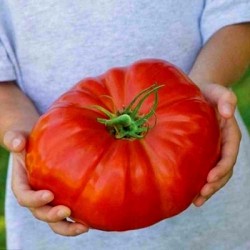
Tres Cantos Biftek Domates...
Fiyat
€1,95
(SKU: VT 42)
Seeds Gallery EU,
5/
5
<h2><strong>Tres Cantos Biftek Domates Tohumları</strong></h2>
<h2><span style="color:#ff0000;"><strong>10 tohum paketi için fiyat.</strong></span></h2>
<p>Tres Cantos domates, Tenerife'den bir yadigar. Adı İspanyolca'dan 'Üç Şarkı' anlamına geliyor. Belirsiz, normal yapraklı bitki, kalın, hafif asidik, domates aromalı büyük miktarlarda 500 g, yuvarlak, sulu, kırmızı domates üretir. Salatalar, konserve ve market için mükemmel seçim.</p>
<p>Biftek domates birkaç tohum ile sulu. Lezzetleri mükemmel, asidik ve tatlı dengesiyle mükemmeldir. Bitkiler güçlü büyüyor, üretken ve destek için uzun bastonlara ihtiyaç duyacaklar. En iyi verim için, yan sürgünleri çıkarın ve bitkiyi bir ana gövdeyle sınırlayın. Çoğu domates hastalığına karşı dayanıklıdır.</p>
<ul><li><strong>Origin</strong>: Tenerife / Spain</li>
</ul>
VT 42 (10 S)

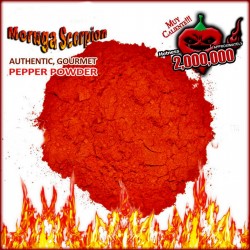
Trinidad moruga akrep tozu...
Fiyat
€1,65
(SKU: Z 6 TMP)
Seeds Gallery EU,
5/
5
<!DOCTYPE html>
<html>
<head>
<meta http-equiv="Content-Type" content="text/html; charset=UTF-8" />
</head>
<body>
<h2><strong>Trinidad moruga akrep tozu Dünyanın En Ateşli</strong></h2>
<h2><span style="color: #ff0000;"><strong>5 g toz paket için fiyat.</strong></span></h2>
<p>Trinidad ve Tobago'daki Moruga bölgesine endemik olan Trinidad Moruga Scorpion (Capsicum Chinense), şu anda dünyanın en sıcak Chili biber çeşididir. New Mexico Eyalet Üniversitesi Chili Pepper Institute, Trinidad Moruga Scorpion'u Şubat 2012 itibariyle dünyanın en sıcak biberidir. New Mexico Eyalet Üniversitesi Chili Enstitüsü'ne göre Trinidad Moruga Scorpion, Scoville ölçeği, bugüne kadar dünyanın en sıcak biberidir.</p>
<p>Chili Enstitüsü'nün tanınmış bir biber uzmanı ve yöneticisi Paul Bosland, "Bir ısırık al. Çok kötü görünmüyor ve sonra inşa ediyor ve inşa ediyor ve inşa ediyor. Bu yüzden oldukça yoğun." Dedi.</p>
<p>Golf topu büyüklüğünde biber, dünyanın en sıcakları arasında sayılan bir avuç chili çeşidi arasında en yüksek puanı aldı. Ortalama ısısı Scoville ısı ölçeğinde 1,2 milyon üniteyi aşarken, bazı bitkilerden meyveler 2 milyon ısı ünitesine ulaştı.</p>
<p>Sıcaktan çıkan Moruga Scorpion, eşsiz bir tatlı-sıcak kombinasyonu yapan, meyveli yumuşak bir tada sahiptir.</p>
</body>
</html>
Z 6 TMP (5g)


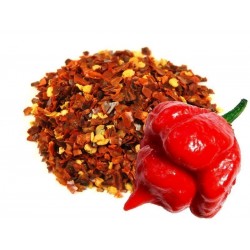
Trinidad Moruga scorpion...
Fiyat
€8,00
(SKU: Z 44)
Seeds Gallery EU,
5/
5
<h2><span style="font-size:14pt;"><strong>Trinidad Moruga scorpion crushed chili - 2 million SHU</strong></span><br /><span style="font-size:14pt;"><strong><span style="color:#d0121a;">The price is for packaging of 50 grams of this spice.</span></strong></span></h2>
<p><span style="color:#000000;"><span>The </span><b>Trinidad Moruga scorpion</b><span> (</span><i>Capsicum chinense</i><span>) is a </span>chili pepper<span> native to the district of </span>Moruga<span> in </span>Trinidad and Tobago<span>. On February 13, 2012, </span>New Mexico State University's<span>Chile Pepper Institute identified the Trinidad Moruga scorpion as the hottest chili in the world, with a mean heat of more than 1.2 million Scoville heat units (SHUs) and individual plants with a heat of more than 2 million </span>SHUs<span>.</span><span> According to the Chile Pepper Institute, the previous record holder was the </span>Bhut jolokia<span> of India, as it never accepted the </span>Infinity chili<span> and </span>Naga Viper pepper<span> that were previous record holders per </span>Guinness World Records<span>. The current world record holder is the </span>Carolina reaper<span> with 1.64 million SHU.</span></span></p>
<p><span style="color:#000000;"><span>Aside from the heat, the Trinidad Moruga scorpion has a tender fruit-like flavor, which makes it a sweet-hot combination.</span><span> The pepper can be grown from seeds in most parts of the world. In North America, the growing season varies regionally from the last spring hard frost to the first fall hard frost. Freezing weather ends the growing season and kills the plant, but otherwise they are perennials which grow all year, slowing in colder weather.</span></span></p>
Z 44


